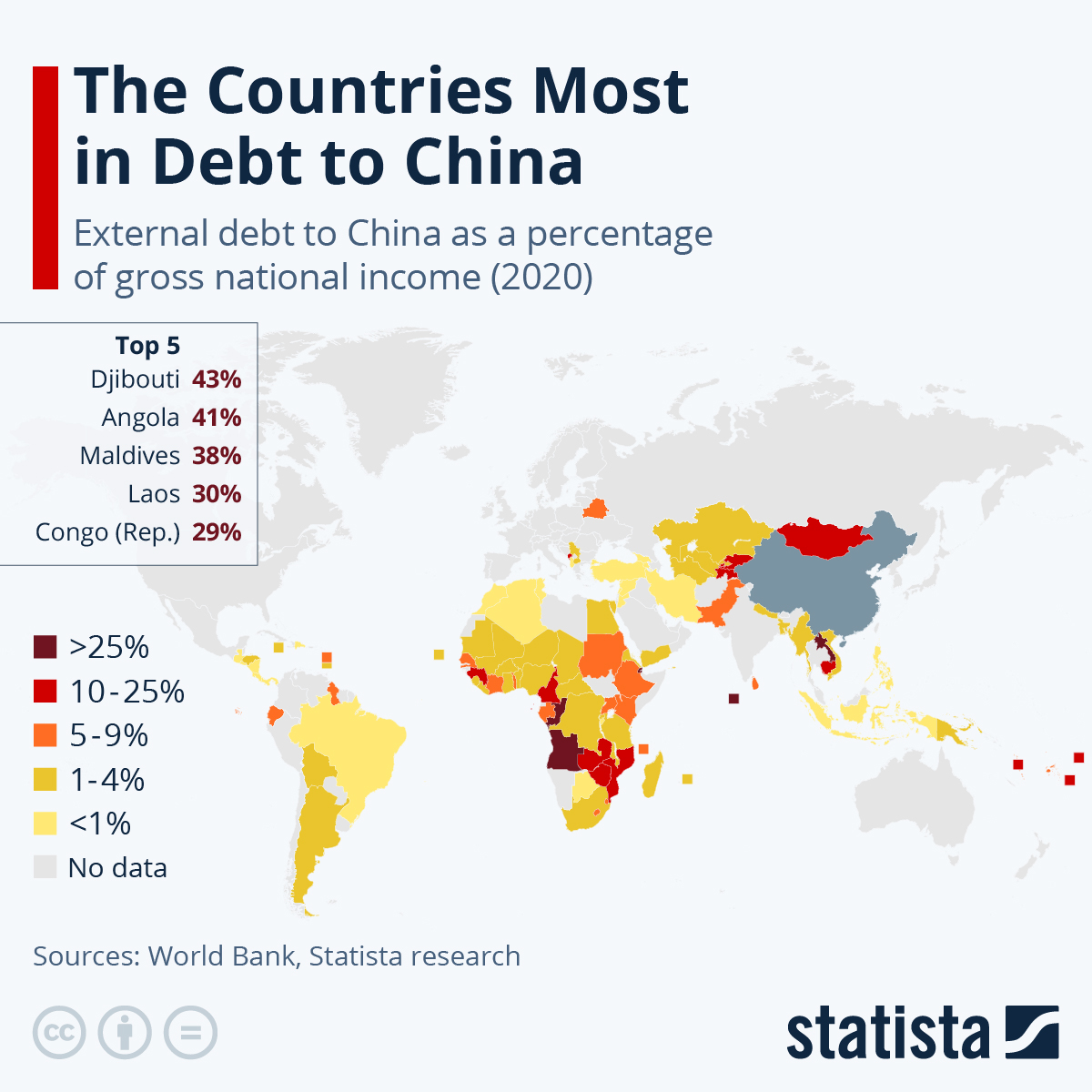
According to World Bank data analyzed by Statista, countries heavily in debt to China are mostly located in Africa, but can also be found in Central Asia, Southeast Asia and the Pacific. As Statista's Katharina Buchholz details below, as the new preferred lender to low-income countries, China now holds 37 percent of these nations' debt. Just 24 percent of the countries' bilateral debt comes from the rest of the world in 2022.
You will find more infographics at Statista
The "New Silk Road" project, which finances the construction of port, rail and land infrastructure across the globe, has created much debt to China for participating countries. At the end of 2020, of the 97 countries for which data was available, Pakistan ($77.3 billion of external debt to China), Angola (36.3 billion), Ethiopia (7.9 billion), Kenya (7.4 billion) and Sri Lanka (6.8 billion) held the biggest debts to China. The countries with the biggest debt burdens in relative terms were Djibouti and Angola, followed by the Maldives and Laos, which has just opened a debt-laden railway line to China. The President of the World Bank, David Malpass, called the level of debt many countries once again hold “unsustainable” in January.
The Paris Club used to hold the majority of low-income countries’ debt before it was restructured and largely forgiven after the turn of the millennium for qualifying, developing countries. Whether such a process will be available for Chinese debt is unclear. As of 2020, China had officially lent around $170 billion to low and middle-income countries, up from just around $40 billion in 2010.
Chinese loans have higher interest rates than those from international institutions like the International Monetary Fund or The World Bank or bilateral loans from Paris Club countries, and also have shorter repayment windows. Their setup is closer to commercial loans concerning their conditions of repayment, confidentiality as well as their objectives of funding specific infrastructure projects instead of pursuing development goals in general.
The Covid-19 pandemic has now complicated the already difficult repayment of Chinese loans even more. According to the Financial Times, the country had to renegotiate loans worth $52 billion in 2020 and 2021 - more than three times the amount that met this fate in the two previous years. One such case was Sri Lanka - also among China’s biggest debtors - which in May was the first Asian country in two decades to default on its debt.
According to World Bank data analyzed by Statista, countries heavily in debt to China are mostly located in Africa, but can also be found in Central Asia, Southeast Asia and the Pacific. As Statista’s Katharina Buchholz details below, as the new preferred lender to low-income countries, China now holds 37 percent of these nations’ debt. Just 24 percent of the countries’ bilateral debt comes from the rest of the world in 2022.
You will find more infographics at Statista
The “New Silk Road” project, which finances the construction of port, rail and land infrastructure across the globe, has created much debt to China for participating countries. At the end of 2020, of the 97 countries for which data was available, Pakistan ($77.3 billion of external debt to China), Angola (36.3 billion), Ethiopia (7.9 billion), Kenya (7.4 billion) and Sri Lanka (6.8 billion) held the biggest debts to China. The countries with the biggest debt burdens in relative terms were Djibouti and Angola, followed by the Maldives and Laos, which has just opened a debt-laden railway line to China. The President of the World Bank, David Malpass, called the level of debt many countries once again hold “unsustainable” in January.
The Paris Club used to hold the majority of low-income countries’ debt before it was restructured and largely forgiven after the turn of the millennium for qualifying, developing countries. Whether such a process will be available for Chinese debt is unclear. As of 2020, China had officially lent around $170 billion to low and middle-income countries, up from just around $40 billion in 2010.
Chinese loans have higher interest rates than those from international institutions like the International Monetary Fund or The World Bank or bilateral loans from Paris Club countries, and also have shorter repayment windows. Their setup is closer to commercial loans concerning their conditions of repayment, confidentiality as well as their objectives of funding specific infrastructure projects instead of pursuing development goals in general.
The Covid-19 pandemic has now complicated the already difficult repayment of Chinese loans even more. According to the Financial Times, the country had to renegotiate loans worth $52 billion in 2020 and 2021 – more than three times the amount that met this fate in the two previous years. One such case was Sri Lanka – also among China’s biggest debtors – which in May was the first Asian country in two decades to default on its debt.





